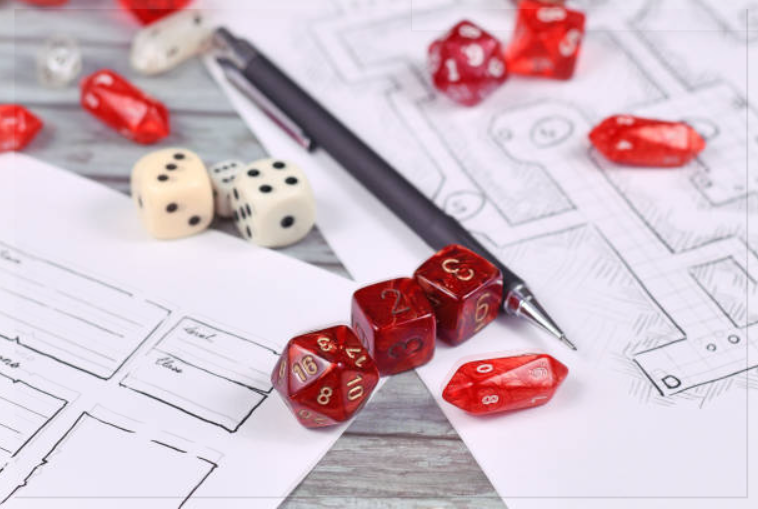How to build a successful TTRPG campaign
 By
Elle Sillitoe
·
7 minute read
By
Elle Sillitoe
·
7 minute read
Top 15 tips for planning, building, and organising a tabletop rpg campaign.

Learning how to craft a TTRPG campaign is akin to stepping into the shoes of an architect, writer, and conductor all at once. Whether you're a seasoned gamemaster seeking new insights or a novice eager to take your first steps into this captivating realm, this guide is tailored to equip you with the tools, techniques, and wisdom to build a successful adventure that will captivate your players' hearts and minds.
In this comprehensive guide, we'll delve into the essential elements of crafting a TTRPG campaign, from the early planning and organising stages to collaborating with other gamemasters in real-time. Whether you're delving into the depths of a dark and dangerous dungeon, exploring the far reaches of space, or unravelling the mysteries of a dystopian future, the principles outlined here will serve as your compass in navigating the TTRPG space. So, assemble your party, gather your dice, and prepare to embark on the unforgettable journey of becoming a gamemaster.
Stage 1: The Architect

The first step to any successful campaign is laying the foundations. Planning is paramount; the decisions and considerations made in the early stages of development craft a framework for the final player experience. So, here's how to devise a comprehensive and consistent game plan:
1. Define your vision
Every successful TTRPG campaign begins with a clear vision. Take some time to brainstorm and define the overarching theme, setting, and tone of your campaign. Are you envisioning a high-fantasy epic set in a sprawling medieval kingdom, or perhaps a gritty cyberpunk saga set in a dystopian future? Consider the genre, atmosphere, and mood you want to evoke, and let your imagination run wild.
2. Establish the setting
Once you've defined your vision, it's time to flesh out the setting of your campaign. Whether you're creating a world from scratch or using an existing setting, take the time to develop key locations, cultures, politics, and historical events that will immerse your players in the world you've created. Help your players visualise this world by creating maps, dungeon plans, and handouts using pen and paper or map maker tools like World Anvil and Inkarnate.
3. Session zero
Another really important, and often overlooked, part of setting up a campaign is having a session zero. This acts as a space to communicate the vision for the campaign, create or share ideas about characters, and discuss the boundaries of play. The boundaries of play lays out how sensitive topics like politics, horror, violence, and romance will be navigated throughout the campaign, giving your players the opportunity to mention any triggers or phobias to avoid. By fostering open communication early on, everyone stays on the same page and gets to enjoy the campaign without the fear of being made uncomfortable.
4. Craft a pilot
The first session of your campaign will essentially act as a pilot episode, meaning that it offers insight into how the players interact with and react to the tone, style, and theme of your campaign. It also demonstrates the compatibility of the players — do the players want to joke around or do they want a serious, grounded experience? How do the players engage with roleplay? Do the party dynamics feel coherent and congruent? Identifying these issues early gives you plenty of time to make adjustments to both your campaign and your players.
5. Collecting feedback
Once you've conducted your first session, make sure to gather as much feedback as possible from the players to gauge insight into their experience. An easy way of doing this is passing around a feedback sheet, however, players might not want to have to sit and fill out paperwork after a long first session.
Therefore, collecting feedback digitally is also a great option — plus it's often easier to organise and refer back to for the game master. There's a ton of different options for collecting feedback digitally; you could set up a discord channel, make a google form, or leave your notes and comments directly in Arcweave.
Stage 2: The Writer

Once the foundations of the story are set, the next step is to start building. Crafting a compelling campaign is more than just assembling a series of obstacles and challenges. It's about immersing players in a world overflowing with magic and intrigue, and weaving together a captivating and engaging narrative. With this in mind, let's get to writing.
1. Come up with a hook:
One of the most crucial parts of writing your campaign is devising a memorable hook, luring players into your imagined world and propelling them into adventure. A great way to make this feel compelling is tailoring it to the backstories of the player-characters.
Let's say that each player-character has experienced the death of a close friend or family member. Well then, perhaps the campaign begins at a graveyard, and the players must band together when the dead start to rise from their graves. Immediately, this begins the campaign with the players being included within the world, rather than introduced to it.
2. Create compelling characters:
A common mistake that both gamemasters and players make is wanting their characters to be the best; the strongest, the scariest, the wittiest, the wisest, the most dashingly handsome. However, the problem with having a character who is already the best is that it leaves them no room to grow, which is essential for a long-lasting campaign.
The most compelling characters have weaknesses and struggles that they must overcome, and motivations that feel grounded in real, weighted human emotions. Perhaps your character dreams of being a master swordsman despite being born blind — their journey would be one of resilience and determination, of navigating the complexities of a labyrinthine world.
3. Construct an engaging narrative:
Craft an engaging and thoughtful narrative which delves deep into the player-characters' backstory. Introduce moral dilemmas that challenge your player-characters' beliefs and values, forcing them to confront difficult decisions which have far-reaching consequences. Embrace player autonomy, offering branching paths which empower the players to shape the story through their choices and actions. Pull from elements of mystery, horror, and even humour to keep the story dynamic and engaging.
4. Design memorable encounters:
Using the player feedback from stage 1, design encounters that take into account the players' preferences, playstyles, and character strengths. Incorporate environmental hazards, interactive elements, and dynamic terrain to transform encounters into living, breathing environments that react to player actions. Introduce diverse villains with distinct personalities, motivations, abilities, and tactics. Don't be afraid to bend the rules — encourage players to approach problems creatively and reward ingenuity even if it might not work. Remember, you're here to have fun!
5. Foster player engagement:
Make your players engaged and invested in the story by creating opportunities for character development and roleplay. Consider where the player-characters grew up, how their experiences of religion, politics, wealth, and war may have scarred them, what connections or relationships they had as a child and how that affected them. The writing of a TTRPG campaign is innately collaborative, so be open to player input and the quality of your narrative will improve tenfold.
Stage 3: The Conductor

With the narrative in place, all that's left to do is orchestrate the play! Every player has a vital role in making your TTRPG campaign a success, but it is your job as the gamemaster to organise, co-ordinate, and direct the party throughout the story as it develops. A huge part of creating a successful campaign is maintaining momentum over a long period of time; here's how to do it:
1. Stick to a consistent schedule:
So, you've meticulously planned every detail of your campaign, written an array of captivating characters, you get around to playing and... the party drops out after the first session. We've all been there. Finding a time when everybody can play, and actually sticking to that time is incredibly important to ensure that the campaign runs smoothly.
If it's necessary, cut down on the runtime of each session to ensure that everyone has the time to attend. Politely request that your players give you notice if they aren't planning on attending a session so that you can plan around their absence and either come up with a reason as to why they have disappeared, or roleplay in their stead.
2. Balancing play:
Balancing play is a delicate art. It's about ensuring that there's enough combat to challenge the players' tactical skills and keep the action flowing while also providing ample opportunities for roleplay and character development. Quiet moments allow for reflection and immersion, while humour adds levity and strengthens the bonds between players. Striking the right balance between these elements over the course of a campaign provides a dynamic and satisfying gameplay experience that never gets boring.
3. Be flexible and adapt:
Improvisation is a cornerstone of TTRPGs. Being a gamemaster means that you very quickly learn to adapt and adjust plans on the fly to accommodate the ever-chaotic and impossible-to-predict party decisions. Whether it's responding to an unexpected throw of the die, incorporating new story threads, or improvising solutions to unforeseen challenges, flexibility allows the gamemaster to keep the experience fluid and engaging.
Adapting to the players' preferences, playstyles, and continuous feedback ensures that the campaign remains tailored to their needs, fostering collaborative and, most importantly, fun gameplay.
4. Organise campaign progress:
Ah, the joys of being a gamemaster... frantically scrambling to try and organise story outlines, character sheets, maps, feedback forms and all manner of notes before every session. With so many things to remember, something always ends up being lost or forgotten which wastes time and resources and potentially damages the campaign.
However, there are many tools out there to make this process a lot easier. For one, Arcweave acts as a central hub for all campaign resources and is easily accessible from any device with access to a web browser. This means that you can keep detailed records of the campaign's progress, allowing you as the game master to weave cohesive plot threads and character arcs with whatever kind of setup suits you the best.
5. Share your campaign:
After putting in all the effort and enjoying the thrill of playing through your campaign, you might feel like you've reached a dead end with nothing more to do. However, that couldn't be further from the truth! Sharing your campaign with your players is just the beginning — the next step is sharing it with the wider TTRPG community.
Whether it's through online forums, communities, or platforms like the Dungeon Masters Guild, sharing your campaign opens up a world of possibilities. It allows you to connect with people from all corners of the globe, exchange ideas, and gather feedback from a diverse array of individuals. So, don't hesitate to share your masterpiece with the world — the lessons you learn may just help your next campaign be even greater.
Empowering the Gamemaster
Gamemasters face many challenges, such as managing the continuity and progression of complex narratives, organising campaign resources, balancing player autonomy, and, the most difficult one of all, finding a time when everyone can actually play. It's not easy, but you're not alone — check out this short video to discover the ways in which Arcweave empowers gamemasters and players alike.
Our web-based narrative design software equips gamemasters with powerful, streamlined tools to bring their visions to life. Best of all, you can try it out for completely free! So, if you need help getting started, feel free to reach out to our team on Discord with questions, queries, or just for a friendly chat.
Max out your gamemaster stat today!